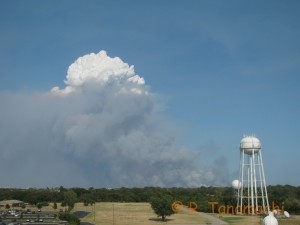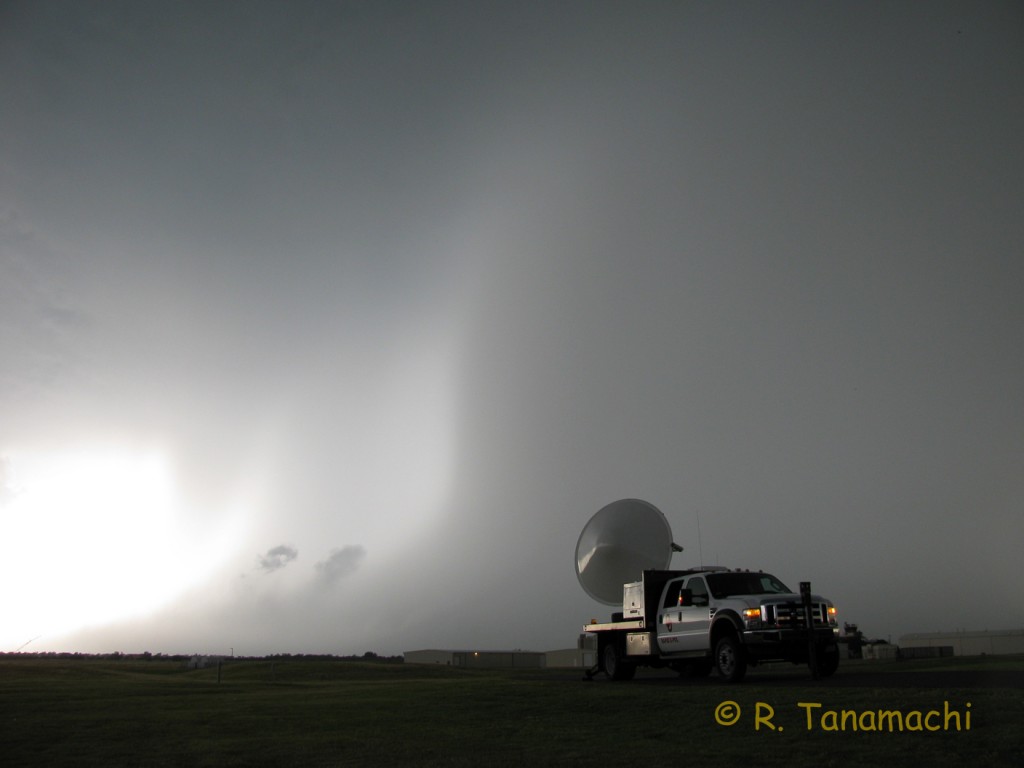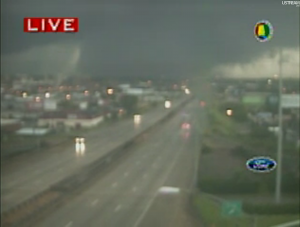Just a quick update on the Mississippi kites I blogged about a few weeks ago. Wildcare, after taking in more than 400 of them in the extreme heat, released the last group in a public event yesterday afternoon. My name was one of the first ones drawn to release one of the kites, and I made it into this video news story from the Daily Oklahoman:
http://newsok.com/multimedia/video/1818632656001
The experience of releasing one of the kites that I had volunteered so many hours to feed was gratifying. Rondi and her staff did an amazing job accommodating and caring for all of them, and they released 85% of the kites in time for their annual migration south. Whenever I hear a Mississippi kite’s distinctive “ke-keeeer” in the sky above me, I can’t help wondering if it’s one of the brood I helped feed.
Category Archives: Weather
Hot topics
After getting off to a comfortable start with slightly above-average rainfall, summer returned with a vengeance to our neck of the woods. Our lawn, once lush with growth, is now mostly brown and crispy underfoot. I cycled home on Thursday evening crossed by a withering, 111 oF southerly wind. Friday, our 16th consecutive day with a maximum temperature greater than 100 oF, saw the introduction of a statewide burn ban as winds gusted to 25 mph. I crossed my fingers that the firefighters would stay bored, but unfortunately a smoke plume appeared southeast of the NWC around lunchtime.

As evening fell, we saw an orange glow on the eastern horizon, like a false dawn, as we walked our dog around the block. We had “grab and go” bags packed just in case the fire decided to get ornery. Fortunately, it remained well east of our neighborhood. However, several of our friends living farther east, along the south shore of Lake Thunderbird, did have to evacuate for a time. The overnight diligence of firefighters kept the flames off their doorsteps. Other people living farther east were not as lucky.
An even bigger fire erupted northeast of Oklahoma City and destroyed significant swathes of Luther, OK. The outrage over the apparent act of arson that started this fire made national headlines. And the danger’s not over – Another week of 100+ oF high temps is on tap, but not a drop of rain in the offing.

I grew up in Minnesota, where we have a certain machismo about winter: bragging about how low the wind chill was while we waited for the bus, how tall the snow drifts at the end of the driveway got, etc. Winter is a fact of life, and we’ve learned to live with it, even celebrate it. I’ve lived in Oklahoma for 10 years now, and found the exact same to be true of Oklahomans and the oven outside. Heck, I’ve even come around to join then. (“Whoa, you cycled when it was how hot?”) Nonetheless, I’m looking forward to the more temperate days of fall. Believe me, they can’t come soon enough!
The “no warning” libel
It happens without fail every year, sometimes several times a year. The world learns that a tornado has ravaged part of America, and it wants to hear more details about what transpired. Reporters swarm in, armed with colorful digit-bearing microphones, and ply the locals for their stories of heartbreak and heroism. Words and images are collected, spliced, and reassembled. A maelstrom of pallid, shell-shocked residents, insulation imitating Spanish moss, and neighbors embracing among splintered homes are beamed to orbiting satellites from dishes.
Whenever I sense one of these pieces is about to air on the evening news, I grit my teeth, as do many of my colleagues. Here it comes…
“There was no warning.”
It’s happened more times than I can count. Reporters seem to go out of their way to find someone, anyone, who claims to have had no warning. And often, they succeed. People gathering up scattered possessions in the wreckage of their homes and lives appear to blurt out, “We had no warning,” as though on cue.
It happened yesterday. During the overnight hours of 22 January, a tornado outbreak impacted “Dixie Alley” in the southeast U.S., and horribly, two fatalities were confirmed. The outbreak occurred overnight, compounding the difficulties in disseminating warnings. The following evening, Dianne Sawyer led off the ABC World News cast thusly:
“Something terrifying took the South by surprise last night. No warning. Twenty-five tornadoes striking in less than 24 hours, roaring through four states in the darkness. And this was the scene today in Alabama, Arkansas, Mississippi, and Tennessee, where entire neighborhoods were wiped out as families slept. At least two are dead, one hundred injured.”
“No warning” is such a familiar refrain, it’s practically a joke. Granted, we meteorologists are accustomed to being the butt of jokes. But “no warning” is worse than a tired tagline or an injurious cliché. It’s a libel that impugns the reputations of my colleagues in the National Weather Service (NWS).
Libel is not too strong a word, because in most instances, a claim of “no warning” (i.e., zero or negative lead time) is unequivocally false. For starters, look at the archived products from the Storm Prediction Center for 22 January 2012. Every Day 1 Convective Outlook issued from 1200 UTC (6:00 a.m. CST) on contains a moderate risk over the outbreak region, the second-highest category of risk and “tornado” appears in the discussion. Tornado watch boxes, many of which were tagged “PDS” (particularly dangerous situation), popped up across the region as early as 5:20 p.m. CST, hours before residents went to bed.
But those are large-scale outlooks spanning several states. What about warnings? The NWS office in Little Rock, AR issued 12 tornado warnings on 23 January (UTC time). The Birmingham, AL office issued 16. The list goes on. Informal accounts from colleagues within the NWS indicate that many of the tornadoes had 20 or more minutes of warning lead time. (The mean lead time for a tornado warning currently stands at 9.5 minutes; Simmons and Sutter 2005.) NWS personnel have no cause to lie or exaggerate on this point, because the warnings, watches, and discussions are all a matter of permanent public record.
But death sells. People die in a tornado, and survivors ask, “Why?” Is anyone to blame when such a violent, seemingly random act of atmospheric violence steals or maims a loved one? Appearing to malign the victims is not an option, even when, by all accounts, the victims are unable, unwilling, or simply too disengaged to even be cognizant of imminent danger. Neither is laying the blame on supernatural powers (for fear of rousing the ire of nonbelieving viewers) or pure chance (which it is not). Who’s left? The organization mandated to issue timely and accurate weather forecasts and alerts to the public: the NWS. NWS personnel are likely to be tied up in the immediate aftermath doing damage surveys and service assessments, and perhaps less likely to respond to such criticisms. So, falling back on the “No Warning” tag line is a safe choice. The viewer is left in a “No Warning” echo chamber. Outrage builds. Legislators demand answers. Something Must Be Done. Despite having carried out their duty to the best of their ability, NWS’s reputation can only erode in the face of such repeated, inaccurate reporting.
The NWS is not a faceless government entity. Flesh-and-blood-human forecasters and support staff work there 24 hours a day, 365 days a year, in largely invisible service to millions of people who will probably never thank them. I know a handful of these forecasters, many of them former classmates. Without exception, they are passionate about their work, despite meager pay, grueling hours, and routinely having to endure slings and arrows of misinformed public opinion.
As a consumer, I challenge ABC to publicly correct the erroneous “No Warning” newscast from 23 January. I would also like to challenge members of the media to verify claims of “no warning” before they are repeated in a national broadcast. Call the NWS office responsible. If you can’t get an answer, query databases of severe thunderstorm and tornado warnings. Here’s one from the University of Iowa that takes only a few seconds to search. (Hint: the prefix for a tornado warning is “TOR”, Ctrl+F will get you a quick count.)
What alternative tack would I suggest? There were other likely contributing factors to the 22 January fatalities that could serve as a starting point for inquiries. For example, residents may not have been as tuned in to the weather as they would have been during the typical “Dixie Alley” storm season (roughly March through May). Nocturnal tornadoes are known to be a disproportionate source of tornado fatalities, because they catch victims in a diminished state of awareness (Ashley et al. 2008).
Remember that viewers at home are the other end of the weather information conduit. If they’re tuned out, all the warnings in the world won’t make one iota of difference. Hook viewers in and empower them with accurate weather safety information well in advance of storm season. Showcase weather radio and publicize severe weather preparedness events every year. Eventually, the defamation of “no warning” will ring as hollow as it truly is, and be replaced by, “Everyone did everything they possibly could have.”
References:
Ashley, Walker S., Andrew J. Krmenec, Rick Schwantes, 2008: Vulnerability due to Nocturnal Tornadoes. Wea. Forecasting, 23, 795–807.
Simmons, Kevin M., Daniel Sutter, 2005: WSR-88D Radar, Tornado Warnings, and Tornado Casualties. Wea. Forecasting, 20, 301–310.
Downburst vs. tornado damage
My video montage of the 14 June 2011 Norman, Oklahoma downburst* now has over 4,800 views, and is, by far, my most viewed video. I’ve received a number of questions (mostly in the form of comments on the YouTube page) regarding the NWS classification of this event as a downburst or “straight-line wind” event. With such extensive damage to roofs, trees, fences, and power lines, it’s not surprising that some have questioned whether a tornado was responsible. Oklahoma is, after all, famously located in the bullseye of Tornado Alley!

The 14 June 2011 Norman high wind event was a downburst. Hands down. End of story.
1) The damage pattern was divergent and widespread.
Downbursts create different damage patterns than tornadoes. Downbursts form when raindrops evaporate as they fall through a layer of dry air. The evaporation process cools the air, which becomes denser and sinks toward the ground. Upon reaching the ground, it has to spread out laterally, creating a divergent damage pattern, as this diagram from Encyclopedia Britannica illustrates:

In contrast, because of the winds spiraling in toward the low-pressure center of a tornado, the damage patterns tend to be convergent, i.e., inward-pointing, and localized along narrow corridors. Britannica again:

However, owing to Newton’s first law, tornadoes can and do eject (centrifuge) debris, so the tornado-damaged area may contain a mixture of convergent and divergent damage. But, downburst damage patterns never exhibit widespread convergence! By all accounts, the 14 June damage was divergent, spreading away from the damaging storm as it passed over the north and east sides of Norman. In addition, the greatest concentration of damage indicators were spread across an area about 7 km wide – far wider than the widest tornado on record (the 4 km-wide Hallam, NE tornado of 22 May 2004):

2) Doppler radar velocity patterns showed divergence, not tornado vortex signatures.
The Norman downburst, which occurred right on top of the National Weather Radar Testbed, was observed by no fewer than six Doppler radars (KTLX, KOUN, TOKC, MPAR, OU-PRIME, and RaXPol, several of which appear in my video).** Without exception, the Doppler velocity data from these radars showed the near-surface divergence signature characteristic of a downburst, not a tornado vortex signature. This animation from KOUN, one of the radars on north base, courtesy of NWS, shows a “wave” of strong outbound (bright red) winds radiating out and away from the radar site:

3) Of the 500+ tornado-savvy meteorologists living and working in Norman, none reported a tornado.
In addition to mechanized observers, there were human observers galore. Of course, not all of them were looking at the storm – some were working, some were home, some were out with their families. But a considerable number, myself included, were out shooting photos or video, and were attentive to the storm’s behavior the entire time. I’d like to think that if there had been a tornado, I would have noticed it. I saw a high-based wall cloud from the north base (visible near the left edge of this photo) several minutes before the downburst struck, but no funnels and no tornadoes. Could hundreds of us have missed a tornado? I don’t think it likely.
Downbursts may not be as photogenic as tornadoes (at least to some people), but they can be just as deadly. Downburst-instigated airplane crashes have killed hundreds of people worldwide. The late Dr. Ted Fujita, who is world-famous for his tornado research, may have saved an equal number of lives via his downburst studies. Thanks in part to his research, specialized, downburst-detecting TDWRs are now installed at major airports. Last summer, I was sitting on a plane at Denver International Airport, when it failed for several minutes to pull back from the gate. Looking out the window, I saw a wall of dust racing toward the airport from the west. My husband speculated aloud that there might have been a microburst, and indeed, his smart phone displayed the divergence signature in data from the Front Range WSR-88D, collected just a few minutes before. We knew what had happened even before the pilot came on the intercom to announce the reason for our delay. And prior to the Norman downburst, no planes took off from or landed at Max Westheimer Airport, which we parked next to. Downbursts are nothing to mess with, particularly when aircraft are involved!
Thanks to Rick Smith and Kiel Ortega for contributing information to this posting.
*Correction: I originally used the word “microburst” in the video title. It emerged later that the damaged area was considerably larger than 4 km in diameter (the characteristic used to distinguish a microburst from a macroburst). I probably should have used the generic term “downburst” (which can include both microbursts and macrobursts) from the beginning. Mea culpa!
**Note: Archived data from the WSR-88Ds and TDWRs is freely available for distribution via NCDC and can be viewed with the Weather and Climate Toolkit. For examples of simulated divergence and vortex signatures, look at Figs. 4.5.1 and 4.5.2 in this online guide.
Oklahoma quiet for now
Although May is the peak of tornado season in Oklahoma and the surrounding southern Great Plains states, we often go for many days in a row without storms as the troughs and ridges march by in slow motion. Things were looking good on Wednesday, May 11th – so much so that I banked up hours to take the afternoon off and go chasing. A negatively-tilted trough, ample deep-layer shear, surface dewpoints approaching 70 F got everyone excited, and SPC issued a moderate risk for the central portion of Oklahoma in their Day2 convective outlook.
Alas, it was not to be. Overnight, a shortwave trough ejected out ahead of the larger, negatively-tilted trough, and the resultant forcing for upward motion set off widespread convection. That morning, I woke up to find that most of western Oklahoma covered by a grungy precipitation shield, and that the SPC had dropped the moderate risk back down to slight. The rain was a good thing for the residents of western Oklahoma, who are experiencing levels of drought not seen since 1988. The net effect of the morning convection was widespread cooling and stabilization of the boundary layer. We decided to call our chase plans off and remain at work. We did have a little fun in Norman that afternoon when a portion of the line strengthened after interaction with an outflow boundary (rain-cooled air pushing outward) from an earlier round of storms, bringing us heavy rain driven by 30 mph wind gusts (at the Norman Mesonet station). A lot of folks at the NWC just stood by the windows and watched.
27 April 2011: Deep south outbreak
27 April 2011 is the type of day no storm chaser wants to see. The damage surveys are still ongoing, and the death toll continues to climb every time I refresh major news sites. As of this writing, the death toll associated with 27 April 2011 (337) has topped the Super Outbreak of April 3-4, 1974 (319).
I can’t claim any ownership of the events. I didn’t chase this outbreak, nor did I chase any of the antecedent storms that grazed Texas, Arkansas, and Louisiana during the prior three days. (Admittedly, I made it as far as Ardmore on Sunday afternoon, before turning around when the first tornadic supercell near Abeliene, TX didn’t hold together, deciding to leave that event to Amos M. and the other chasers already there.) Even if I could have made it to the target area, I think the chase would have been exceptionally challenging (terrain, trees, debris blocking roads, poor visiblity, etc). I also might have run the risk of becoming a victim and requiring assistance that would otherwise be given to local survivors – a position I hope I never come to find myself in.
I was certainly aware of the high risk convective outlook from SPC as I went about my business on Wednesday. Around 4:30 p.m. CDT, my husband materialized in my office and told me a tornado was bearing down on Tuscaloosa, AL, and that Lou W. was watching a live tower cam stream in his office. I arrived to find that a small crowd had gathered, and a powerful tornado was squarely in the tower cam’s sights on ABC 33/40 on UStream.

It’s one thing to watch a tornado dance and dart over open prairies, perhaps shredding a shed or a fence or toppling a few power poles along the way. It’s quite another to watch a fat barber pole churn through a populated area, know that it is killing people, and understand that, even with years of knowledge and experience, there is absolutely nothing you can do about it. I felt physically nauseated, and utterly helpless. In those moments, I literally hated being a meteorologist. Why did this happen? There is no easy answer. The winds blow when and where they may. All we can do is read the signs beforehand, and try, with renewed focus, to learn the lessons that the atmosphere is teaching us.
To start that process, I’ll posit two observations I made during and immediately after the event. The first was that footage of the the Tuscaloosa tornado bore a striking resemblance to Earle Evan’s footage of the Andover, Kansas tornado of 26 April 1991 (a staple of the Tornado Video Classics series that I and many other storm geeks grew up on). The condensation funnel itself appears gray, while darker, diagonal vortices whirl around the base, like a diabolical parody of a barber pole. I was not the only one who noticed the Andover-esque appearance of the Tuscaloosa tornado; when I posted that comment on Facebook, I was rewarded with a resounding chorus of “I was just thinking that!”) I’ll venture that, while striking, the resemblance is coincidental, and while it may indicate that the two tornadoes share some similar characteristics (such as width, moisture content, debris content, and swirl ratio), the resemblance itself doesn’t have a great deal of scientific significance.
My other observation has to do with the SPC preliminary storm reports from April 27. There’s a noticeable dearth of other-than-tornado reports across Mississippi and Alabama, compared to surrounding areas. The tornadic supercells that raked across Mississippi and Alabama must have also produced hail and damaging wind gusts, so where were all the reports? When I pointed this pattern out to some of my colleagues, speculating that spotters were opting to report tornadoes rather than hail or high winds, the response from my colleagues within the NWS was overwhelmingly in the affirmative. The SPC preliminary reports are aggregated from Local Storm Reports (LSRs) compiled by local NWS offices, and NWS doesn’t censor any of the reports coming in (except for the obvious hoax reports). So the bias towards tornado reports in that area arises from the spotters’ individual choices. If you’re watching a tornado while 2″ hail is falling around you, what are you going to report? The hail, or the tornado? Ideally, you’d want to report both, but you can’t report both at the same time. I know that I’d opt to report the tornado first, and the hail second.
We still have much to learn from this outbreak, but more urgently, the survivors of these storms need help. The storm outbreak itself lasted four days (25 – 28 April 2011) and impacted areas ranging from central Texas to Washington, D.C. In my judgment, the most effective way to extend a helping hand from a distance is to donate to charitable organizations such as the Red Cross. You can also text “tornado” to 50555 to give $10 to United Way of Alabama. Of course, money isn’t the only resource needed; I’ve got an appointment on Monday with the local blood bank.